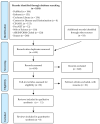Cancer Incidence and Mortality among Firefighters: An Overview of Epidemiologic Systematic Reviews
- PMID: 33802629
- PMCID: PMC7967542
- DOI: 10.3390/ijerph18052519
Cancer Incidence and Mortality among Firefighters: An Overview of Epidemiologic Systematic Reviews
Abstract
Firefighters are exposed to carcinogens that may increase their risk of developing many types of occupational cancer. Many systematic reviews (SRs) have been produced with sometimes conflicting conclusions. In this overview of reviews, we aim to assess the conclusion consistency across the available systematic reviews on the cancer risk in firefighters. Literature searches were conducted in several indexed databases and grey literature to retrieve systematic reviews aiming to evaluate cancer incidence or cancer mortality in firefighters. Results from included SRs were analyzed according to the tumour site. Out of 1054 records identified by the search in the databases, a total of 11 SRs were ultimately included. The original studies (n = 104) analyzed in the SRs were published between 1959 and 2018. The results consistently reported a significant increase in the incidence of rectal, prostate, bladder and testicular cancers as well as mesothelioma and malignant melanoma in firefighters compared to the general population. The SRs also indicate that death rates from rectal cancer and non-Hodgkin's lymphoma are higher among firefighters. Consistent SR results suggest that several types of cancer may be more frequent in firefighters than in the general population.
Keywords: carcinogens; contaminants; firefighters; occupational health.
Conflict of interest statement
The authors declare no conflict of interest.
Figures
Comment in
-
Comment on Laroche, E.; L'Espérance, S. Cancer Incidence and Mortality among Firefighters: An Overview of Epidemiologic Systematic Reviews. Int. J. Environ. Res. Public Health 2021, 18, 2519.Int J Environ Res Public Health. 2022 Jun 21;19(13):7558. doi: 10.3390/ijerph19137558. Int J Environ Res Public Health. 2022. PMID: 35805217 Free PMC article.
-
Reply to Guidotti, T. Comment on "Laroche, E.; L'Espérance, S. Cancer Incidence and Mortality among Firefighters: An Overview of Epidemiologic Systematic Reviews. Int. J. Environ. Res. Public Health 2021, 18, 2519".Int J Environ Res Public Health. 2022 Jun 21;19(13):7560. doi: 10.3390/ijerph19137560. Int J Environ Res Public Health. 2022. PMID: 35805219 Free PMC article.
References
-
- Guidotti G.T. Health Risks and Occupation as a Firefighter: A Report Prepared for the Department of Veterans’ Affairs. Department of Veterans’ Affairs, Commonwealth of Australia; Brisbane, Australia: 2014. 192p
Publication types
MeSH terms
Substances
LinkOut - more resources
Full Text Sources
Other Literature Sources
Medical
Research Materials



